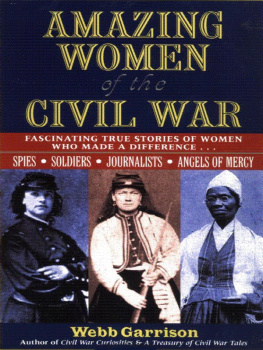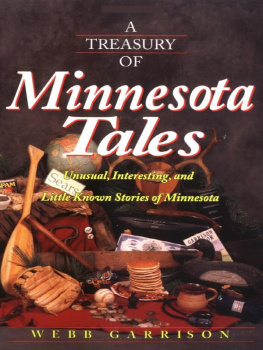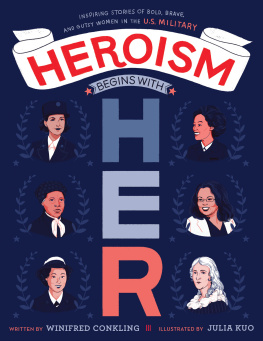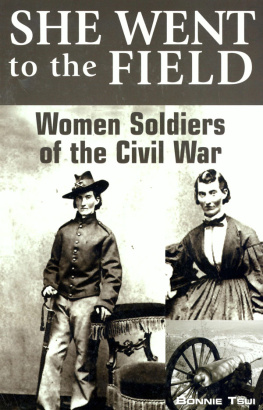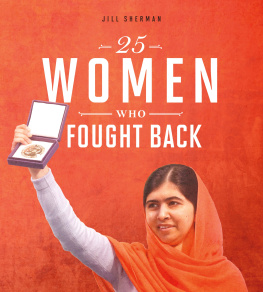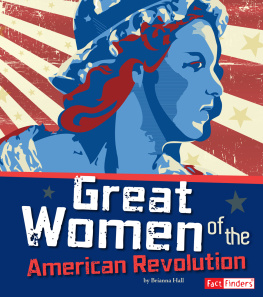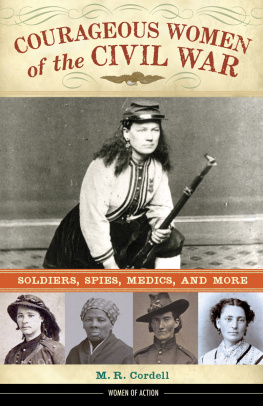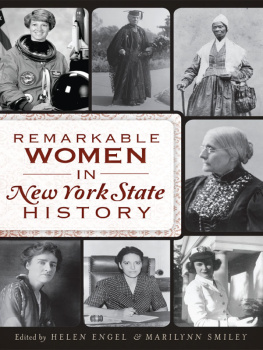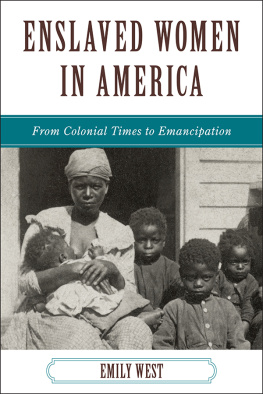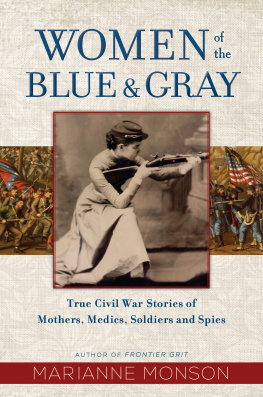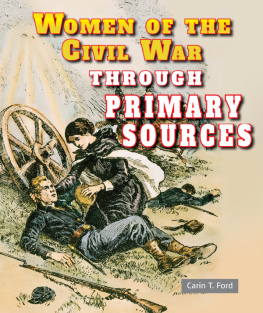Amazing Women
of the Civil War
Amazing
Women
of the
Civil War
WEBB GARRISON
Rutledge Hill Press
NASHVILLE, TENNESSEE
Copyright 1999 by Webb Garrison
All rights reserved. Written permission must be secured from the publisher to use or reproduce any part of this book, except for brief quotations in critical reviews or articles.
Published by Rutledge Hill Press, Inc., 211 Seventh Avenue North, Nashville, Tennessee 37219-1823.
Distributed in Australia by The Five Mile Press Pty., Ltd., 22 Summit Road, Noble Park, Victoria 3174.
Distributed in Canada by H. B. Fenn & Company, Ltd., 34 Nixon Road, Bolton, Ontario L7E 1W2. Distributed in New Zealand by Southern Publishers Group, 22 Burleigh Street, Grafton, Auckland.
Distributed in the United Kingdom by Verulam Publishing, Ltd., 152a Park Street Lane, Park Street, St. Albans, Hertfordshire AL2 2AU.
Cover design by Schwalb Creative Communications, Inc.
Typography by Roger A. DeLiso, Rutledge Hill Press, Inc.
All photos are from the authors private collection, unless otherwise noted.
Library of Congress Cataloging-in-Publication Data
Garrison, Webb B.
Amazing women of the Civil War / Webb Garrison.
p. c.m.
Includes index.
ISBN 1-55853-791-0 (pb)
1. United StatesHistoryCivil War, 18611865Women Anecdotes. 2. WomenUnited StatesBiographyAnecdotes. I. Title.
E628.G37 1999
973.7'082 21dc21
99-32580
Rev
Printed in the United States of America
1 2 3 4 5 6 7 8 904 03 02 01 00 99
Contents
T he Civil War was fought largelybut not exclusivelyby men. Long ago, someone came up with a ballpark figure of about three hundred women who actually fought in either blue or gray. Although that figure cannot be documented or confirmed, it is widely cited. The truth of the matter is that no one knows precisely how many females went into Rebel and Federal fighting forces because many of them were disguised as males and were extremely clever. What makes this number even less accurate is that the most clever of them were probably never discovered.
Even so, three hundred female soldiers, more or less, represent only a minute fraction of the total number of troops that clashed on one battlefield after another for the 1,400-day duration of the war. Although their roles as soldiers are fascinating and absorbing, these women were not, by any stretch of the imagination, important to the outcome of any single armed clash.
Civilian life during the Civil War, however, tells an entirely different story. Here, women were almost as involved in the crisis as the fighting men they saw go off to war. In the United States and the Confederacy during the years 1861 to 1865, there were very few passive spectators. Life at home was almost as fully transformed as life in the camps and on the fields, albeit not nearly so fraught with imminent danger.
A glance at this books table of contents indicates that women played many roles during the Civil War. Whats more, only a small fraction of the millions who were caught up in the war are represented in this volume. Women had an important role. They became intimately and personally involved in raising money, making army shirts, being nurses, and acting as volunteer spies on both sides. They helped shape the course of the intensifying struggle in which Americans slaughtered Americans by the tens of thousands.
The chronicles they left behind of the tiny fragments of the war in which they were involved have no clear counterparts. Though seemingly infinitesimal in the larger scope of the war, we owe female diarists and letter writers a tremendous debt for spotlighting events about which wed know little or nothing if we were limited to traditional (masculine) sources.
Although they differed so widely in their wartime activities that no two women whose stories are included here are alike, all had one significant element in common. Each had memorable experiences. When we view these experiences and the war at large through their eyes, we realize that all women, on both sides of the conflict, were civilian casualties of one sort or another. The wealthy and powerful labored and suffered as much as the obscure and humble.
A special debt of gratitude is owed to Bill, Cheryl, Mary, and Webb Jr.all of whom have the same surname. These Garrisons pitched into this project and worked very hard to gather and sort through source materialthe quest for some of which was comparable to having teeth pulled without anesthesia. Dr. John Simon of Southern Illinois University graciously gave permission to use a rather long quotation from the only existing biography of Julia Dent Grant.
Heres hoping that a vicarious adventure into the lives of three dozen amazing women from the Civil War will give you a new outlook on this troubled time in American historyand more important, that youll thoroughly enjoy getting to know these women as real people instead of just names in a reference book.
Amazing Women
of the Civil War
Part I
ALLS FAIR IN LOVE AND WAR
CHAPTER
Sarah Edmonds,
aka Frank Thompson
Nurse and Spy
A bill granting a pension to Mrs. Sarah E. E. Seelye, alias Franklin Thompson Be it enacted by the Senate and House of Representatives of the United States of America in Congress assembled; that the Secretary of the Interior is hereby authorized and directed to place on the pension roll the name of Sarah E. E. Seelye, alias Franklin Thompson, who was a late private in Company F, Second Regiment of Michigan Infantry Volunteers at the rate of $12 a month.
P assed in early July 1884, the above bill was signed into law after just a few days by President Chester A. Arthur. As a result, the nurse and spy who was known to comrades as Frank Thompson drew a pension of $144 per year for fourteen years as a Civil War veteran.
Born in New Brunswick, Canada, Frank began life as Sarah Emma Edmondson, fifth daughter of a farmer. Her father, Isaac, openly lamented that his son, Thomas, had no outdoor interests, so Sarah did her level best to fill a spot that her brother didnt seem willing to occupy. She became an expert rider and a skilled shot with a squirrel rifle; for a time, she went so far as to wear trousers to please her father. He acted as though she had done nothing for him, however, and was so brusk and harsh that in secret talk with her siblings she began referring to him as the brutal father. There are no hints that Sarah was sexually abused by Isaac, but she despised him so thoroughly that she ran away at about age sixteen and dropped the last two letters from her surname.
Looking back on her life in later years, she said that the name change was the first step she had taken in a desperate search for independence and an entirely new kind of life. Once on her own and earning a pittance in a millinery shop, she might have been forced into prostitution had she not been struck with a brilliant idea. Since all jobs worth having went to men, she reasoned, why not become a man and get one of them?
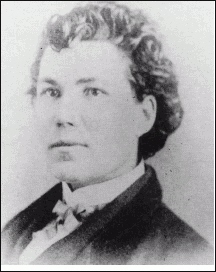
Pvt. Franklin Thompson, 2nd Michigan
Volunteer Regiment.MICHIGAN STATE ARCHIVES
She may have decided to take that drastic step as a result of having seen an advertisement placed by a book publisher in distant Boston, Massachusetts. According to a notice in a provincial newspaper, the L. P. Crown firm was in immediate need of one hundred men who were willing to hustle and who were disposed to act as agents. For practical purposes, that meant the company was ready to put men to work as door-to-door salesmen and pay them a small percent commission of their sales. Men who would come to Boston to make application in person were certain to be the ones most likely to be hired.
Next page
